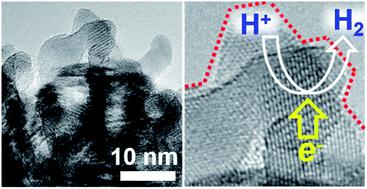当前位置:
X-MOL 学术
›
J. Mater. Chem. A
›
论文详情
Our official English website, www.x-mol.net, welcomes your
feedback! (Note: you will need to create a separate account there.)
Active faceted nanoporous ruthenium for electrocatalytic hydrogen evolution
Journal of Materials Chemistry A ( IF 10.7 ) Pub Date : 2020-09-22 , DOI: 10.1039/d0ta04223d Abdillah Sani Bin Mohd Najib 1, 2, 3, 4, 5 , Muhammad Iqbal 4, 5, 6 , Mohamed Barakat Zakaria 7, 8, 9, 10, 11 , Shusaku Shoji 4, 12, 13, 14, 15 , Yohei Cho 4, 12, 13, 14, 15 , Xiaobo Peng 4, 5, 6 , Shigenori Ueda 4, 5, 5, 16, 17 , Ayako Hashimoto 4, 5, 6 , Takeshi Fujita 4, 18, 19, 20 , Masahiro Miyauchi 4, 12, 13, 14, 15 , Yusuke Yamauchi 7, 8, 9, 10, 11 , Hideki Abe 1, 2, 3, 4, 5
Journal of Materials Chemistry A ( IF 10.7 ) Pub Date : 2020-09-22 , DOI: 10.1039/d0ta04223d Abdillah Sani Bin Mohd Najib 1, 2, 3, 4, 5 , Muhammad Iqbal 4, 5, 6 , Mohamed Barakat Zakaria 7, 8, 9, 10, 11 , Shusaku Shoji 4, 12, 13, 14, 15 , Yohei Cho 4, 12, 13, 14, 15 , Xiaobo Peng 4, 5, 6 , Shigenori Ueda 4, 5, 5, 16, 17 , Ayako Hashimoto 4, 5, 6 , Takeshi Fujita 4, 18, 19, 20 , Masahiro Miyauchi 4, 12, 13, 14, 15 , Yusuke Yamauchi 7, 8, 9, 10, 11 , Hideki Abe 1, 2, 3, 4, 5
Affiliation

|
Nanoporous ruthenium (np-Ru) comprising reaction active facets is synthesized from a ruthenium–cerium (Ru2Ce) alloy precursor. Spontaneous nanophase separation of Ru2Ce in an oxidative atmosphere results in a lamellar nanocomposite consisting of Ru metal and cerium oxide (CeO2). Selective leaching of the Ru–CeO2 nanocomposite in sulfuric acid yields np-Ru with a high surface area of 48 m2 g−1, predominantly surrounded by reaction active {10![[1 with combining macron]](https://www.rsc.org/images/entities/char_0031_0304.gif) 0} facets. Active-faceted np-Ru efficiently catalyzed the hydrogen evolution reaction (HER) in acidic media at an overpotential of +74 mV vs. the reversible hydrogen electrode, which is 20 mV lower than that for carbon-supported Ru (Ru/C) and rather close to +58 mV for state-of-the-art Pt/C. Np–Ru has great potential in broad applications such as hydrogen battery electrodes because of its low HER overpotential and scalable synthetic protocol.
0} facets. Active-faceted np-Ru efficiently catalyzed the hydrogen evolution reaction (HER) in acidic media at an overpotential of +74 mV vs. the reversible hydrogen electrode, which is 20 mV lower than that for carbon-supported Ru (Ru/C) and rather close to +58 mV for state-of-the-art Pt/C. Np–Ru has great potential in broad applications such as hydrogen battery electrodes because of its low HER overpotential and scalable synthetic protocol.
中文翻译:

活性多面纳米孔钌用于电催化制氢
由钌-铈(Ru 2 Ce)合金前体合成了具有反应活性面的纳米多孔钌(np-Ru)。Ru 2 Ce在氧化气氛中的自发纳米相分离产生了由Ru金属和氧化铈(CeO 2)组成的层状纳米复合材料。Ru-CeO 2纳米复合材料在硫酸中的选择性浸出产生np-Ru,其高表面积为48 m 2 g -1,主要被反应活性{10![[1个结合宏]](https://www.rsc.org/images/entities/char_0031_0304.gif) 0}面包围。活性面NP-茹有效催化的在酸性介质中的氢生成反应(HER)在的超电势74毫伏与可逆氢电极,它比碳载Ru(Ru / C)的氢电极低20 mV,而对于最新的Pt / C,则接近+58 mV。Np-Ru具有较低的HER过电位和可扩展的合成协议,因此在氢电池电极等广泛应用中具有巨大的潜力。
0}面包围。活性面NP-茹有效催化的在酸性介质中的氢生成反应(HER)在的超电势74毫伏与可逆氢电极,它比碳载Ru(Ru / C)的氢电极低20 mV,而对于最新的Pt / C,则接近+58 mV。Np-Ru具有较低的HER过电位和可扩展的合成协议,因此在氢电池电极等广泛应用中具有巨大的潜力。
更新日期:2020-10-06
![[1 with combining macron]](https://www.rsc.org/images/entities/char_0031_0304.gif) 0} facets. Active-faceted np-Ru efficiently catalyzed the hydrogen evolution reaction (HER) in acidic media at an overpotential of +74 mV vs. the reversible hydrogen electrode, which is 20 mV lower than that for carbon-supported Ru (Ru/C) and rather close to +58 mV for state-of-the-art Pt/C. Np–Ru has great potential in broad applications such as hydrogen battery electrodes because of its low HER overpotential and scalable synthetic protocol.
0} facets. Active-faceted np-Ru efficiently catalyzed the hydrogen evolution reaction (HER) in acidic media at an overpotential of +74 mV vs. the reversible hydrogen electrode, which is 20 mV lower than that for carbon-supported Ru (Ru/C) and rather close to +58 mV for state-of-the-art Pt/C. Np–Ru has great potential in broad applications such as hydrogen battery electrodes because of its low HER overpotential and scalable synthetic protocol.
中文翻译:

活性多面纳米孔钌用于电催化制氢
由钌-铈(Ru 2 Ce)合金前体合成了具有反应活性面的纳米多孔钌(np-Ru)。Ru 2 Ce在氧化气氛中的自发纳米相分离产生了由Ru金属和氧化铈(CeO 2)组成的层状纳米复合材料。Ru-CeO 2纳米复合材料在硫酸中的选择性浸出产生np-Ru,其高表面积为48 m 2 g -1,主要被反应活性{10
![[1个结合宏]](https://www.rsc.org/images/entities/char_0031_0304.gif) 0}面包围。活性面NP-茹有效催化的在酸性介质中的氢生成反应(HER)在的超电势74毫伏与可逆氢电极,它比碳载Ru(Ru / C)的氢电极低20 mV,而对于最新的Pt / C,则接近+58 mV。Np-Ru具有较低的HER过电位和可扩展的合成协议,因此在氢电池电极等广泛应用中具有巨大的潜力。
0}面包围。活性面NP-茹有效催化的在酸性介质中的氢生成反应(HER)在的超电势74毫伏与可逆氢电极,它比碳载Ru(Ru / C)的氢电极低20 mV,而对于最新的Pt / C,则接近+58 mV。Np-Ru具有较低的HER过电位和可扩展的合成协议,因此在氢电池电极等广泛应用中具有巨大的潜力。











































 京公网安备 11010802027423号
京公网安备 11010802027423号